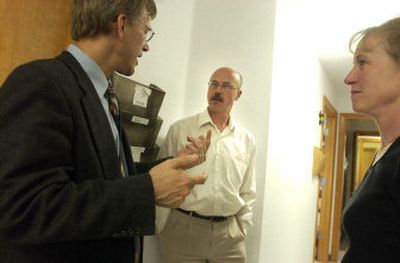Health care faces dilemma

Since Coeur d’Alene’s free health clinic became a federally funded community health center a year and a half ago, more people than ever have been able to access affordable health care in Kootenai County.
But the flood of patients just seems to keep growing, and the clinic — even with a full-time staff — can’t keep up.
The clinic, now called the Dirne Community Health Center, is finding that it has to turn away more uninsured patients because it can’t afford to treat them all.
About 400 people are on a waiting list to get in to see a doctor at the health center.
These are folks who typically don’t have insurance, or are on Medicare or Medicaid, and can’t get into see any other doctors, who aren’t taking any new patients on the federal insurance programs.
“There isn’t any (doctor) in town who will take Medicare anymore,” said Donna Austin, a Dirne board member and patient, who is on Medicare herself.
Kootenai County has an estimated 25,000 uninsured residents, while the statewide estimate is a quarter million uninsured.
In fact, several Dirne staff members were laid off in the spring because the clinic was treating too many uninsured patients and couldn’t cover all its costs — even with its $650,000 annual federal grant.
“It’s a dilemma. It’s frustrating,” said Joel Hughes, CEO of the clinic.
To address this dilemma, shared by federally funded health care centers statewide, the Idaho Primary Care Association is proposing legislation that would expand Medicaid coverage in a special program for adults who earn up to 150 percent or 185 percent of the federal poverty level.
Now, Idaho’s Medicaid program only covers children, the disabled and pregnant women, said Bill Foxcroft, IPCA’s executive director. Adults who can’t afford medical insurance tend to put off their health care needs until the last minute, and then often wind up in the emergency room, health professionals say.
And if they can’t pay those expensive hospital bills, they often have to turn to the county indigent and state catastrophic funds for help, according to the IPCA, which represents the state’s community health centers. The state would save money if more people got their health needs addressed upfront instead of after a crisis, the IPCA argues.
On Tuesday, Foxcroft presented the proposal to members of the Dirne clinic’s board of directors. Last week, the proposed program was introduced to the Legislature’s Health Care Task Force in Boise.
Under the proposal, qualified individuals would get a state subsidy of up to $75 per month to purchase a high-deductible insurance plan. In addition, the state and the individual would contribute $25 each month to a “primary care account.”
The account, a medical care savings account, would collect about $600 per year, which could be used to cover the unpaid balance of a visit to a federally funded health clinic.
That would allow Dirne to see more uninsured patients, Hughes said.
Each office visit costs $100, he said. “Most of our patients, probably 80 percent, are at or below 100 percent of the poverty level, of which we charge them $10 at the time of service,” Hughes said. “That means we have to supplement that with $90.”
Hughes was hoping Congress would increase the appropriation for community health centers, but with the recent hurricanes in the Gulf Coast region, that’s highly unlikely.
Another threat to the community health centers, Foxcroft told the Dirne board, is a recent bill in Congress that would allow other types of health care facilities to access the grant funds now used by the community health centers. The “Healthy America Act,” however, would not require that the federal funds be used to provide health care access for the uninsured, he said.
If the patient has Medicaid or Medicare, those insurance programs will cover the office visit at a community health center. The idea is to get more people on Medicaid and into the examination room.
The state has to come up with 30 percent of the cost to expand Medicaid, however, while the federal government — if it approves of the program — would cover the other 70 percent.
Sources for the state’s share of the increase could come from the general fund, the cigarette tax, the health insurance premium tax or other revenue, according to the association.
Hughes said the statewide proposal is similar to a local program that the health center is discussing with the city of Post Falls, which has been unable to extend health care coverage to its retirees who aren’t old enough to qualify for Medicare.
“There’s a gap,” he said. “It’s not affordable for many of those people who are retiring.”
Local solutions are going to be part of the mix that makes a community health center truly one that serves the whole community, Hughes said. For instance, he’s also talking to the county about finding more inexpensive ways to serve the medical needs of jail inmates.
“We have to look at this and figure out how we as a community can step up and solve access to health care for individuals who don’t have resources,” he said. “We have to really be creative.”